It’s kinda funny, but a car manufacturer’s best seller isn’t generally a car any more, it’s some kind of SUV. Buyers love ’em, so marketers keep serving them up, and none is more popular than the so-called medium, the segment where these four vie for your hard earned.
Mazda’s CX-5 is popular, featuring in the top sellers list for the past few years. Honda has been in this game for more than 20 years with the CR-V, and Honda NZ says its new model will become its best seller this year. The European brands are playing catch up in this arena but are arriving well armed, the new Kodiaq Skoda’s first (real) attempt at an SUV (the Yeti, really?) and will also become the brand’s top model (if they can meet demand). Even the French are branching out, Peugeot’s new 3008 arriving here with its recently awarded Euro COTY crown, which is the first SUV to win the top gong in the award’s 64-year history. Told you the Euros were playing catch up.
So how do these new Euro offerings match up with those more established Japanese models? We gathered a quartet, two from each camp and each a fresh arrival on the scene this year. They are the top dogs within their respective ranges, all with at least one turbocharger, and a replete spec sheet. But which to choose? Though they all compete in the same sphere, there are some marked differences between them, and so they will appeal to slightly different buyers in the end. But what’s our choice?
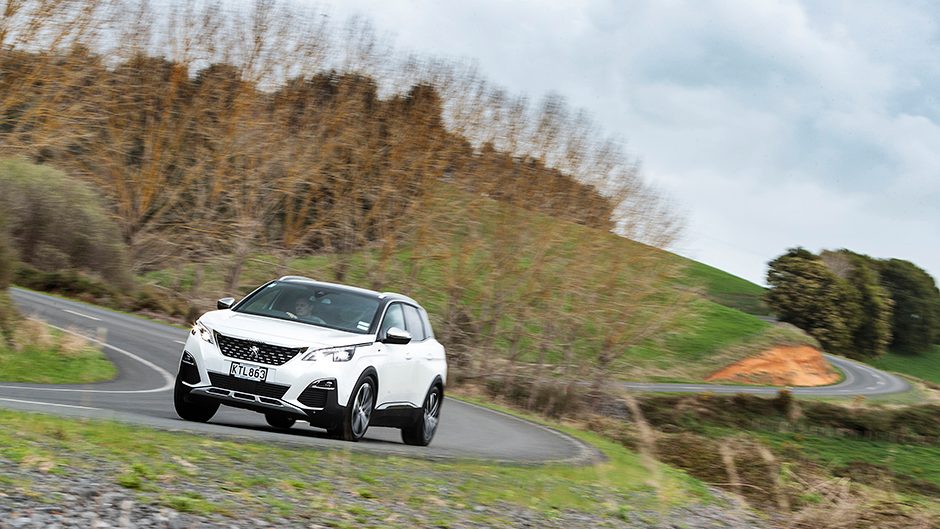
Peugeot 3008 – the stylish one
One way to stand out in a crowd is to look good, and that’s the 3008. It’s the most interesting to gaze upon, those alluring curves of the sheetmetal are matched by the avant garde interior. Its style will woo buyers with design concepts not usually seen at this price point. Inside, there’s the configurable 12-inch instrument display which you can set to reflect your mood, and it’s positioned high with the squished steering wheel sited below. The cabin is crafted in a cockpit fashion, encapsulating its occupants with the high-rise central console, complete with its joystick-style gear selector. Then there are the materials; quality plastics, alcantara for effect, lined door pockets even, and suave looking seats that you can set to massage. Hard plastics are scarce, and it’s all squeak-free. A pity the electric adjustment on the driver’s seat worked intermittently, meaning some simply couldn’t get comfortable at the wheel. The warranty period extends to three years and 150,000km on this 3008.
Most controls default to the large central screen, which means a few taps are needed to set things up, but the claw-like buttons below it lend a few shortcuts to various menus. Navigation and smartphone connection are sorted. There’s a charge pad, and though the glovebox is filled with fuses and a perfume dispenser, and the cup holders are too small, the centre storage bin is useful.
Peugeot’s ancient cruise control wand is still in use, yet it has been successfully adapted to the needs of active cruise. There’s the suite of safety helpers, though the active lane keeping function puts up a fight for the steering so is best switched out, and while there’s active cruise, it lacks the helpful stop and go function in traffic queues.
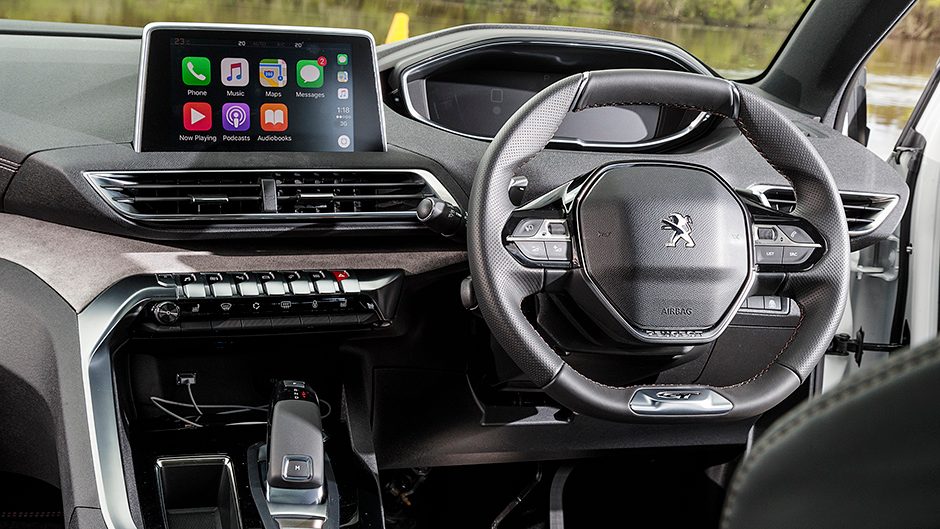
The 3008 is the cosiest of the quartet inside with just enough room in the rear quarters, though the seat is comfy, and there’s sufficient headroom even with the full-length sunroof (which we could probably live without). It has the smallest usable boot space, even when you position the variable boot floor to its lowest setting. The seats fold easily enough with remote levers, which all the vehicles here have, but the Peugeot’s squabs sink down to present a flat load space. This is the lone one with a hands-free tailgate, waggling your foot about beneath the rear bumper will activate the powered tailgate. All the others share the powered fifth door facility. The Pug will tow a maximum of 1600kg.
The GT is powered by a 2.0-litre diesel featuring 133kW and 400Nm. It’s a Euro6 compliant unit, rated at an optimistic 5.1L/100km but a figure in the mid eights, even the sevens, is achievable. It works via a six-speed auto, and is the lone model here to employ the front wheels solely for motivation, as no 3008 offers AWD. So it’s unlikely to find much favour outside main city centres this, but it’s more of an urbanite anyhow.
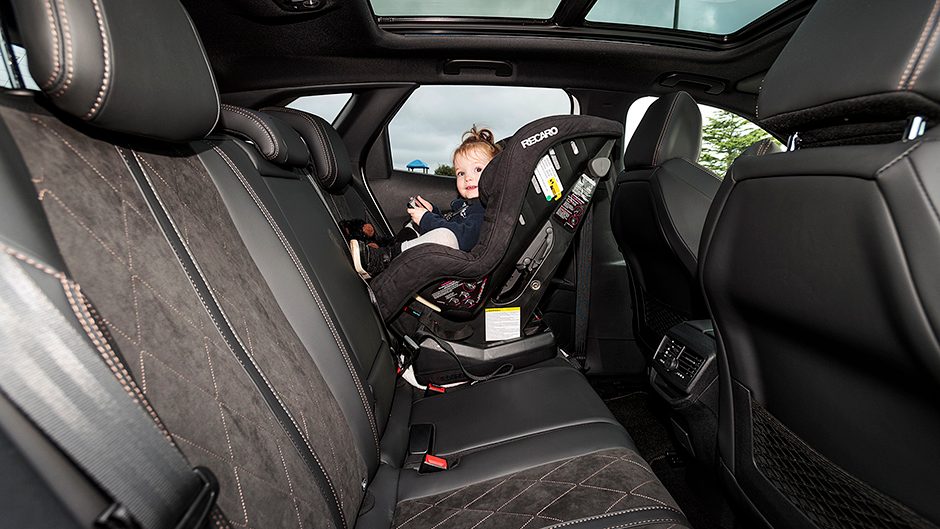
The diesel is responsive from both low revs and in the mid-range, with little lag to speak of. And while there’s some torque reaction at the wheel, the front wheels manage to deploy most of the substantial squirt efficiently. The stop/start system is quick to kill the engine, even before you’ve come to a halt (not so great when you are trying to park) but is also quick to refire the action.
The town ride is smooth for the most part, though more troublesome bumps ruffle the rear end, and amongst this company, the 3008’s torsion beam set-up can be exposed both in and out of town. Activating Sport mode improves the 3008’s reactions out in the wilds, and it gets along well, the engine revving to about 4500rpm, quite vocally thanks to a sound enhancer, but there’s also some road roar evident in the Peugeot. It has a reasonably entertaining chassis, untoward movements well controlled and Peugeot adding its passive rear steer knowhow to get it round corners nicely – just when you think the front is about to let go, there’s a shimmy from the rear to ease the burden on the front, tightening the line. The steering is a little too aloof, even in Sport mode. Its small wheel is good for cruising and commuting, promoting a relaxed but assertive grip, but it lacks leverage in the turns, the weighting and feedback light too.
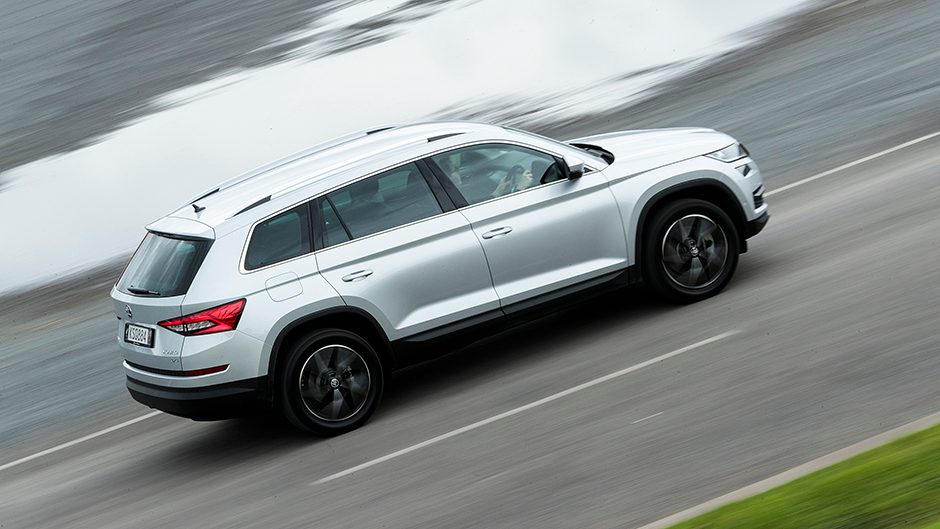
Skoda Kodiaq – the practical one
Skoda make practical vehicles, and the Kodiaq’s no different there. To that end, it sports a function-over-form design which leads to big proportions and this is a substantial rig amongst this company. It’s big, but it also provides seating for up to seven, and AWD. Other seven seaters in this space, think X-Trail and CR-V, are front drivers only.
Kodiaq is smart but not flashy, which usually suits Kiwi buyers, and for a first effort, this is a well executed SUV. Inside it’s spacious up front, utterly conventional yet modern. It has the best infotainment system with a big, clear and responsive touchscreen. The functionality is deep, with smartphone link-up and voice control. Docking the Kodiaq isn’t hard with a self parking function and a rear view and surround view camera too, while all around vision is sound. The seats up front will suit most body types, and come with both ventilators and heaters, though a little more padding would be nice. There’s no lack of storage, the centre bin and door pockets sizeable, and lined too. There are hideyholes and little everyday solutions everywhere, like the removable torch in the boot and umbrellas in the doors. There’s a helpful infusion of tech too; a charge pad, easily accessible aux and USB points, two SD slots in the glovebox and all the driver assist features. While lacking any real design flair, the build and materials used are quality.

The space theme continues in the rear with leg room aplenty, especially with the seat, the only one here on sliders, positioned all the way rearward. In the boot are some handy load securing features, and a pair of foldaway seats. The space is limited however, more suited for kids but you have the added versatility if you need it. These rob a little load space, especially height wise, but you’ll still fit plenty of stuff inside. To meet demand, Skoda NZ is doing the five-seater version for those that have no need for the extra seats. They still charge the full whack, but you do get extra cargo volume, the five pew model rated at 720L to the seven’s 630L.
In the top Style model you can go petrol or diesel, this one being the 2.0-litre oiler. We might suggest the petrol more worthy however. The diesel makes good numbers, 140kW and 400Nm, but it’s not as responsive below 2000rpm as the others here, with a bit of a wait for the goodness to arrive, before coming on in a great surge. It’s strong in the midrange but with seven gears in the economy-minded twin-clutch gearbox, it’s often hovering around 1500rpm, and so requests for added urge take a moment as the box changes down. The diesel is said to be Euro6 compliant, 5.7L/100km on average the claim, though low eights are more the reality and easily achievable with a mix urban and motorway cruising. Skoda quote service intervals of up to two years and 30,000km, depending on your use.
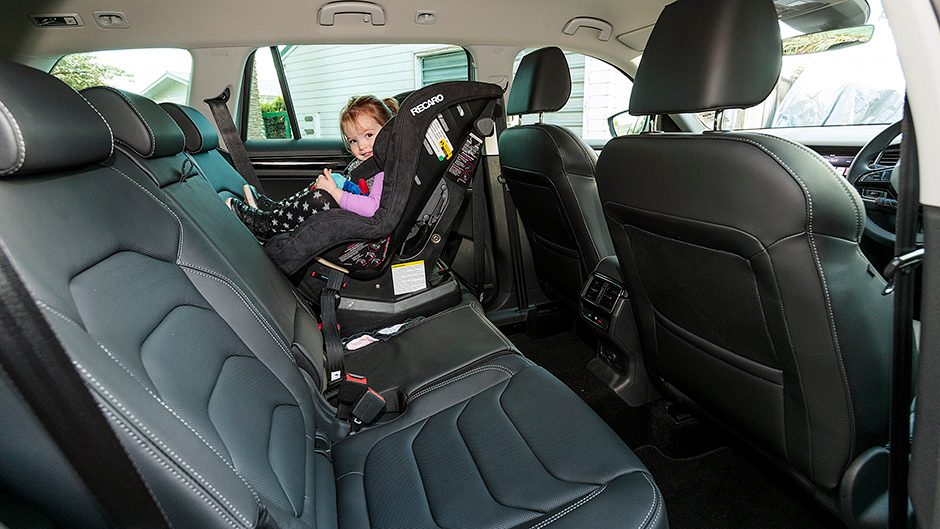
Helped by a multitude of drive modes and adaptive dampers, Kodiaq is one competent drive, but you do need to fiddle with those settings to get the best of it. Comfort delivers as intended, the ride quality in town and on byways of real note, as is the lack of road noise. The transmission can be a tad too relaxed, but this is quickly remedied by pulling back on the lever to access Sport mode when snappier reactions are desired, which is helpful in both town and country running. Full Sport mode for the suspension puts a firmer control on roll, but you feel those bumps too. You can configure the Individual mode to amp up the drivetrain and steering while relaxing the suspension to eases the bumps but still maintain control. Some steering heft helps in negotiating those faster bends, though the Kodiaq succumbs to cornering forces sooner than the 3008, and the Mazda too. Like all products off this VW platform, it’s safe and secure if a tad sterile. There’s an off-road mode for the traction and on-demand AWD system, and with the right tow hook it can haul a maximum of 2000kg. There’s also an optional trailer backing assistant.
The active cruise is easily set, and features low speed assistance, but a smoother approach to stopping and starting wouldn’t go amiss, as would some polish on the idle stop’s restart action. There’s a lane keeping assistant too, which is pretty strict on the use of indicators; fail to use them when merging and it’ll tell you about it.
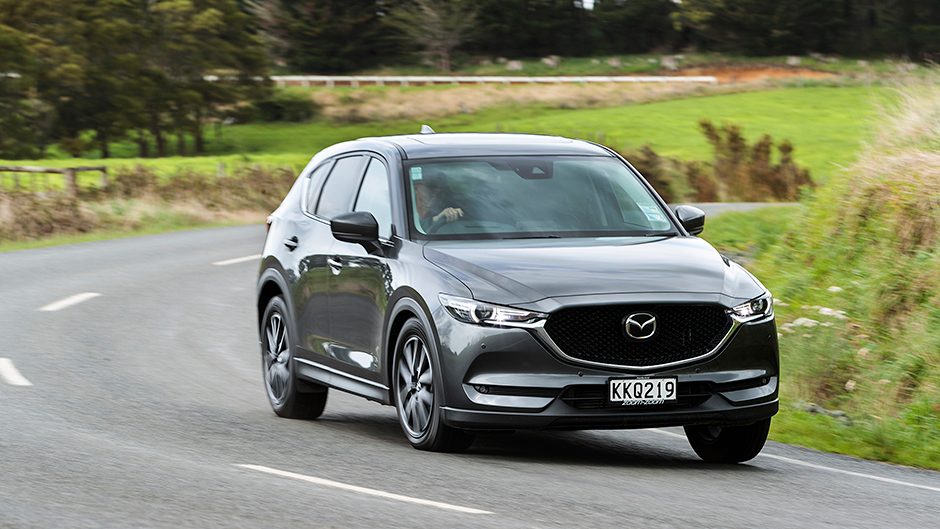
Mazda CX-5 – the driver’s one
Now in its second generation, the new CX-5 marks a full renewal of the Mazda range under its new, and highly successful Skyactiv program with its modular chassis and common drivelines. Along with a mandate of lower real world fuel consumption, designing vehicles with the driver in mind is still at the centre of what Mazda does. And that’s helped the CX-5 carve out a substantial share of the crowded mid-size SUV market, along with its blend of quality, refinement and relative value. The CX-5 doesn’t turn off disinterested folk by being too driver focused however, but rather it connects subtly. Of the gathered metal, it’s the best drive here. It’s not reliant on multiple set-up modes, there isn’t even a Sport mode button (what?). You just get in, drive and it delivers. The engine, a 2.2-litre diesel is the pick here, a real gem. With a sequential bi-turbo arrangement, the little blower is quickly up to speed to eliminate the lag effect, and when the bigger turbo starts puffing, it’s mighty strong through the midrange. This revs with gusto and doesn’t feel stretched when pushed to 5000rpm and beyond. It’s only Euro5 compliant, but that meets NZ regs, and it’s a little thirstier, rated at 6.0L/100km (the trip computer average was in the high eights to low nine area on test). With a well honed AWD system, all that good go is maximised, while the six-speed auto is well adept at keeping the engine happy with smooth but slick and well programmed shifting.
This new CX-5 is much improved on the refinement front, being whisper quiet on coarse chip highways. It can be easy for the speed to creep up, there’s no increase in road and wind roar, so remember to use that cruise control. And despite its quiet nature, it’s far from muted at the wheel. The steering is exemplary with good weighting, feedback and response. The suspension calms ill-mannered roads, yet untoward body movements are managed in fine fashion too. Crack on and the chassis communicates the limits well, the stability aids letting the driver have the first stab at correcting things before lending a hand, but you hardly ever see the ESC light blinking.
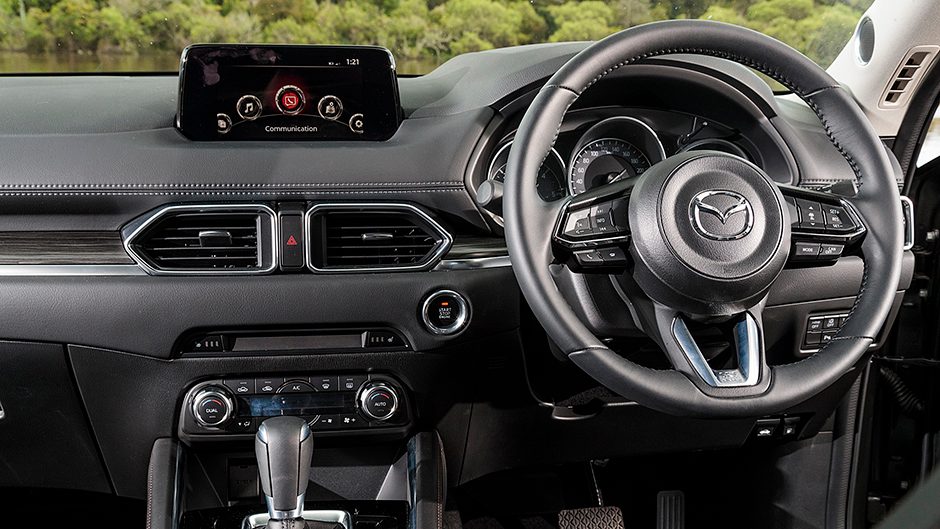
It’s equally adept at city work with light steering, good outward vision, and that ever-ready torque eases commuting. The fixed rate dampers do a good job on the ride too. Mazda’s stop-start system is superior to that of the others, the pressure you place on the brake pedal ultimately controlling its operation, and its restart procedure is more seamless. The active cruise takes care of traffic flows, and the safety helpers are just that, helpful rather than annoying. With no active lane keeping, just a gentle reminder to keep you alert in your lane, we didn’t feel like switching this lane departure system off. The cabin is quite conservative but the quality is arguably the best here; it’s lovingly crafted with a stitched dash and a high level of finishing throughout the interior, even in the boot area. The seats offer both comfort and just enough support, and plenty of adjustment to sort the driving position, while the leather feels of a higher grade than that used by the others.
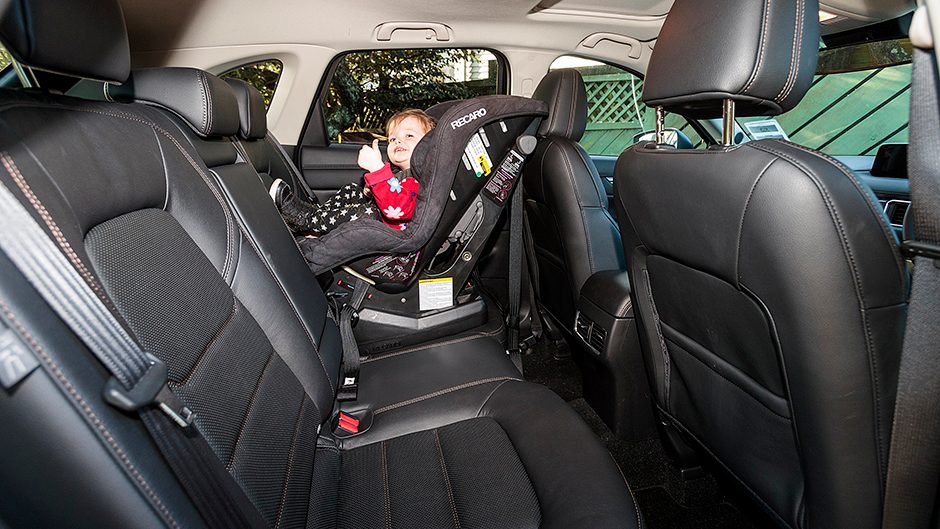
CX-5 is popular perhaps because it’s conventional in operation, with just enough tech to keep people happy. Its infotainment system uses a mix of mouse and touchscreen controls and is generally easy to fathom, but the screen’s a bit small, and it could process things faster. It’s the only one lacking CarPlay and Android Auto, but the CX-5 is the lone offering with a head-up display as standard which relays plenty of useful information, with blind spot alerts and speed limit display. The storage could be better, the centre bin small, as are the door pockets, though they are rubber lined to stop things clanking around.
There’s not quite the stretch space in the back seat as that offered by the Honda or Skoda, but nor will adults struggle for comfort. CX-5 is roomier inside than its outward appearance suggests. There’s a practical, well-shaped hold with good width and height and a 40/20/40 split folding seat might help come time to load longer things like skis, and carry passengers. The towing capacity is a Kodiaq-equalling 2000kg. It comes too with Mazda’s three year’s servicing and five-year warranty programme.
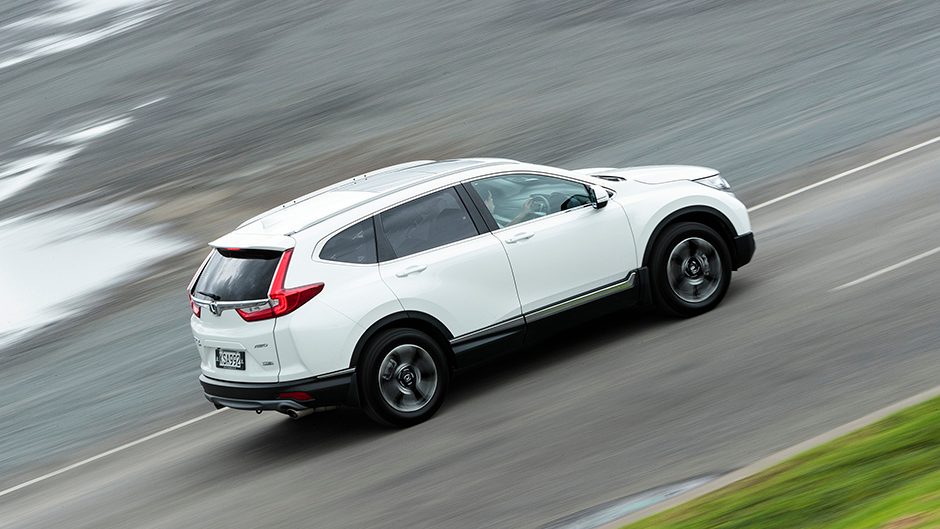
Honda CR-V – the one for value
Honda is enjoying a revival of late, finally trotting out some all-new products after a few years in the doldrums post GFC. The CR-V, in its fifth generation, sports a new chassis and turbocharged petrol engine technology. The former brings increases in cabin space and body rigidity for improved road manners and refinements, while the latter gives the CR-V a boost of easy-going performance. It might only have a 1.5-litre engine, but size isn’t such an issue in this day and age. A development of the Civic unit, it has a bigger turbo with an emphasis on low-end torque production. Sure, it doesn’t front with the same shove as the larger capacity diesels with just 240Nm, but with 140kW, neither is it utterly outclassed on either performance or fuel consumption, thanks in part to its CVT auto. This often maligned transmission lends it a smooth operation. It’s silky on the uptake and uses that low end torque to get up to speed. It then reduces the ratio to keep the CR-V cruising along in the 1500-2000rpm area for calm, economical progress. Yeah, to get moving it requires a more liberal use of the go pedal, but again the CVT is obliging, quickly probing the engine for added go, and it’s moving along nicely by 4000rpm. Slipping the lever into the S mode helps too, the CVT set to keep revs simmering higher and react quicker to the gas pedal. As long as your right foot is not completely leaden, expect fuel use in the eight to nine litre per 100km bracket, all without the need for any idle stop function (the official figure is 7.4L/100km). And as you can see from the performance figures, the CR-V isn’t slow, as the petrol can rev harder and longer, the CVT stepping through simulated gears to prevent it whining away as the early generation CVTs were want to do. And with faster acting on-demand AWD, there’s no slippage either.
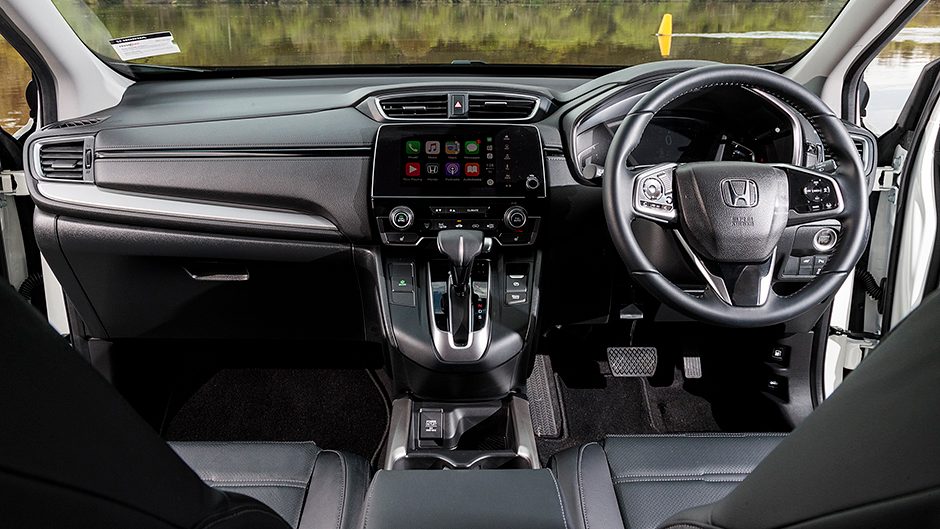
With a quick steering rack, just 2.1 turns between the stops, this is easy as in the suburbs. Matched to the powertrain character is a smooth suspension set-up, the softest here. It means it’s also the most prone to roll in corners. CR-V can’t foot it with the CX-5, or the 3008 in corners, while the Kodiaq too is more sure-footed. Though it wears a Sport badge, it’s more about getting the kids to sport on Saturday than a sporting drive. The steering points it accurately and it turns quickly, but lacks outright grip and the torque vectoring by brake gets a good workout if you push the envelope. The ride’s always good though, and the 1.5 delivers enough urge when pressed. Road and wind noise could be better suppressed.
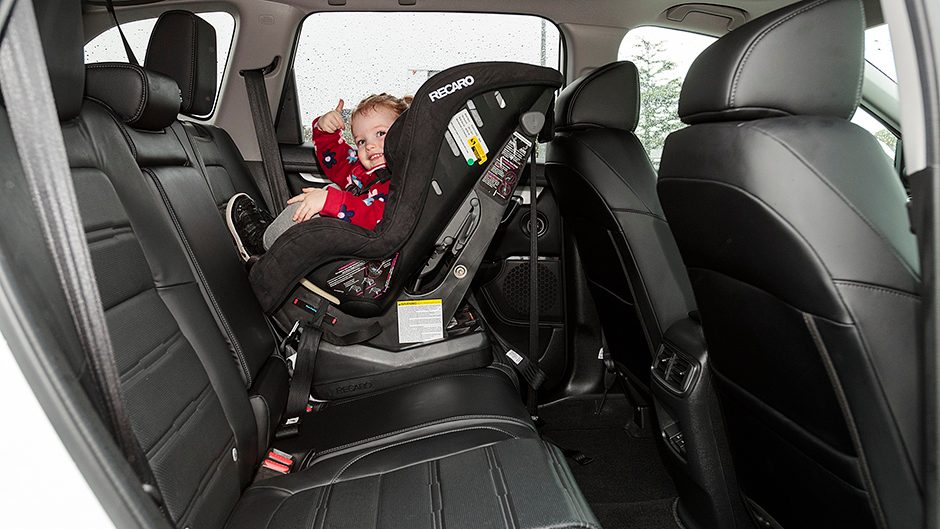
There’s no lack of space inside the CR-V, rivalling the Skoda in this regard for practicality. There’s oodles of rear leg room, and with a flat floor, it’s more accepting of a middle passenger. The seat is right comfy too, reclining nicely, though the panoramic roof robs a little headroom for taller folk. While teens will like the USB charge points in the rear, the roof-mounted child seat tether points aren’t that smart. This has the most usable boot space with a low-set floor and it’s wide between the wheel arches, with good length too. And it’s the only one with a full size spare, the rest having space savers.
Compared with the others, the interior exhibits less panache. There’s nothing iffy about the build and finishing, but there’s more of a built-to-a-price-point feel about the trim. The seats are wider with Americans in mind, and there’s plentiful storage with a ginormous centre console bin, big cupholders, and door pockets though none is lined. And the fake stitching effect is just naff. The CR-V also has the most frustrating multimedia centre, with a few too many buttons to push to get things done, and it’s not the most logical system. It is smartphone ready however so you can circumvent it all. While it lacks blind spot monitoring, the rest of the active safety stuff is present, the active cruise with low speed operation, and lane keeping which is a more conservative helper than the Euro examples. The CR-V is covered by Honda’s five-year unlimited kay warranty, though servicing is extra.
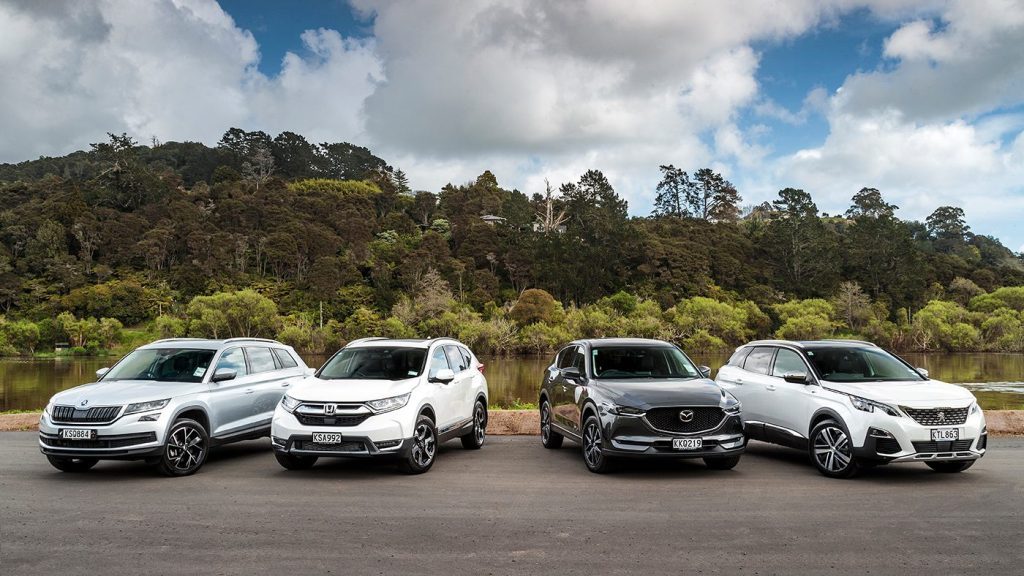
A summary
One thing we haven’t mentioned yet are the prices, and that’s where the Honda CR-V carves out a march on the others. We name it the value king here, being competitive yet undercutting them nicely. All of the model ranges start at a tantalising $39,990 for front drivers with lesser powertrains and few frills and then there are middling models, with a bit more fruit and power, while the CR-V also offers a 2WD seven-seater version. But as to those gathered here, the top 3008 GT is $54,990 (and you can add options on top of that), the CX-5 Limited diesel is $57,990 and the Kodiaq Style diesel is $58,290, before adding options. The top CR-V Sport Sensing is just $47,900. It’s not the best one here however, but for some, that value might be just too hard to overlook. The Peugeot 3008 you’ll buy for its style, which it thankfully can back up with some substance, it’s powertrain likeable, so too the driving characteristics and all of its natty little interior features. It’s not the most versatile, or practical but it brings some real flair to this end of the market. As to the best it’s between the Skoda and Mazda and as we said in the intro, they’ll have different appeal. If it’s practicality, space and the need for seven seats, Skoda will see you right. It’s supremely competent though we say check out the petrol, as it’s $4000 cheaper. But for all-round appeal, it’s the CX-5 that we prefer. Its refinements and driver appeal are hard to top in this class, as is the performance of its engine. Add in the feature-laden, quality-rich interior with just enough space, and it’s clear to see why it finds favour with so many buyers.
| Model | Skoda Kodiaq Style TDI |
| Price | $58,290 |
| Engine | 1968cc, IL4, TDI, 140kW/400Nm |
| Drivetrain | 7D, on-demand AWD |
| Fuel Use | 5.7L/100km |
| C02 Output | 151g/km |
| 0-100km/h | 8.13sec |
| Weight | 1873kg |
| Model | Honda CR-V AWD Sport Sensing |
| Price | $47,900 |
| Engine | 1498cc, IL4, T/DI, 140kW/240Nm |
| Drivetrain | CVT, on-demand AWD |
| Fuel Use | 7.4L/100km |
| C02 Output | 168g/km |
| 0-100km/h | 8.84sec |
| Weight | 1608kg |
| Model | Peugeot 3008 GT |
| Price | TBA |
| Engine | 1997cc, IL4, TDI,133kW/400Nm |
| Drivetrain | 6A, FWD |
| Fuel Use | 5.5L/100km |
| C02 Output | 124g/km |
| 0-100km/h | 9.305sec |
| Weight | 1634kg |
| Model | Mazda CX-5 Limited diesel |
| Price | $57,990 |
| Engine | 2191cc, IL4, TDI, 129kW/420Nm |
| Drivetrain | 6A, on-demand AWD |
| Fuel Use | 6.0L/100km |
| C02 Output | 158g/km |
| 0-100km/h | 8.67sec |
| Weight | 1725kg |


